The Unseen One of Green Ammonia
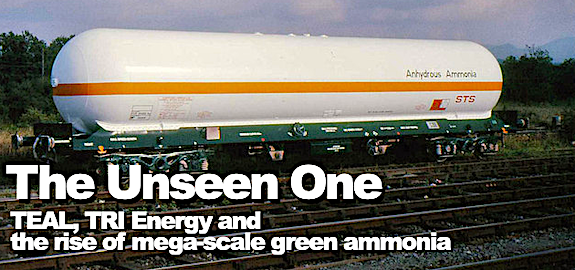
“The wind blows where it wishes, and you hear the sound of it, but do not know where it comes from and where it is going.” John 3:8
Lately there has emerged a worship of cleaner ammonia as a hydrogen carrier and for use in fertilizers and industry, so we might as well revive the Cult of Ammon, for whom the molecule was named. Ammon was the principal god of ancient Thebes, his cult emerged in prehistory out of the Nubian reaches of the Upper Nile and predates pottery.
When Thebes achieved the unification of Egypt, Ammon transformed into Ammon-Ra, and he symbolized the sun, and the wind, and fertility of the soil — his name comes from the Nubian phrase for the invisible power, the unseen one — and isn’t it fitting that here in the 21st century, ammonia’s story (named after ammonium salts found at his temple complex at Siwa), is all mixed together with renewable power, the pursuit of fertile soils, and the molecule that you see when you look in the sky towards the sun, for that is hydrogen.
When the Egyptians painted Ammon’s portrait, he was blue. Today, we might paint him teal — a little green mixed in with the blue to symbolize the transition from grey ammonia (made from natural gas) to blue and green ammonia made with renewable goals in addition to the functional one.
Bring Out Your Benjamins
What they could not paint was what you could not see, the invisible power, the unseen force. If it were left to me to name that unseen force in the rise of green ammonia at scale here in the 2020s, I would take us from the labs and the projects and into the jungles of finance. The Benjamins and the Franklins. These are big projects, the costs can run well over a billion dollars per. At deployment scale, green ammonia becomes less of a technology story and more of a financial story, more Wall Street than Sand Hill Road.
And so, in relating the story of Teal Energy & Chimie, let me introduce one of the wizards of the financing rather than the technologist, one Henry Val of TRI Energy.
Henry’s conversation rarely turns out terms such as team methane reformation, the Haber-Bosch process, or green electrolysis. He speaks the language of deals, and it is a language all bioeconomy companies will learn that reach for, er. bioeconomies of scale.
“I’ve been on Wall Street since 1983,” Val tells the Digest. “I’ve been i many, many deals, several deals in renewable energy, smart cities. A lot on medical, water treatment, solar.”
He speaks of sectors, and investors, he speaks of loan tenor, basis points above LIBOR, permits, traunches, mezzanines, bridging, offtakes of the “take or pay” type, power purchase agreements that are generally called PPAs. Above all, in finance the conversation shifts quickly away from the What and Why to the How, always the When, and above all, the Who.
“We have one billion committed,” Val blithely relates of Teal’s first project, in Quebec. “We have $300 million to go. There are lots and lots of investors, serious investors, who love infrastructure deals.”
On Wall Street there are few Buddhists but the hum of committed investor brands is a chant, a sacred utterance, with a focus and awareness like a Buddhist’s road to samadhi, along the Noble Eightfold Path. There are several syllables in every good project’s mantra, in Teal’s case I can only repeat one, that is Carlyle.
In project finance, the lead sponsor is the unspoken answer to every question, it is the invisible hand, the radiant invisible radiation energy, the Ammon-Ra. They never say it but you can hear it, like the wind. Why this Project? Carlyle. Who will determine the timelines and scale? Carlyle. Why will this project succeed? Carlyle. No matter the question, the answer is Carlyle. Carlyle, Carlyle om mani padme Carlyle. Shantih shanith shantih.
Project Sizes Worthy of Ammon-Ra

You can see from this investment deck slide the kind of numbers we’re looking at here, financially speaking. $5.75 billion in capital to get the projects build and more later in expansion, 4.6 million tons of green and blue ammonia.
The Ins and Outs
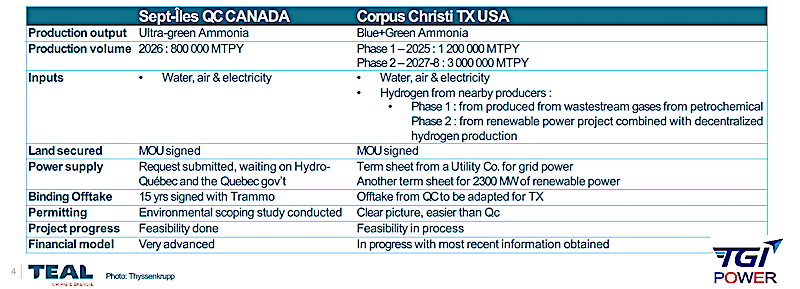
And this slide tells us more about the inputs and the outputs. The Quebec project is all green, the Texas projects are blue and green ammonia. In these presentations, you’ll see far less about technology milestones and timelines, and more about power supply, land, binding offtake agreements, and the permitting progress.
Market of Markets
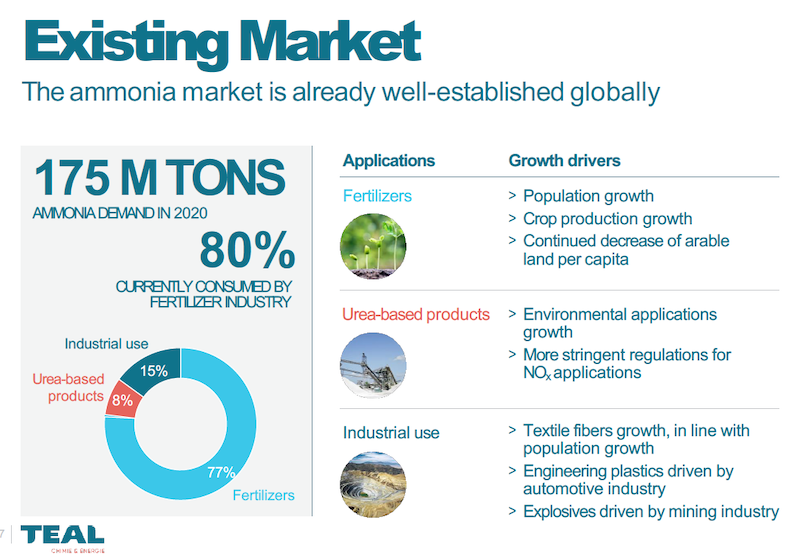
How big is the ammonia market? 175 million tons, this slide says — so, this entry is not for the faint of heart, it’s aiming to capture some 3 percent or so of the world market. Here in Digestville we’d only add that we really don’t know what the demand for ammonia will be until we consider what the demand will be for ammonia as a liquid hydrogen carrier and a storage medium. It’s one heck of a lot easier to run a marine ship on hydrogen fuel cells with liquid ammonia than compressing hydrogen, and more efficient. To give an example.
The Hockey-Stick of Gain
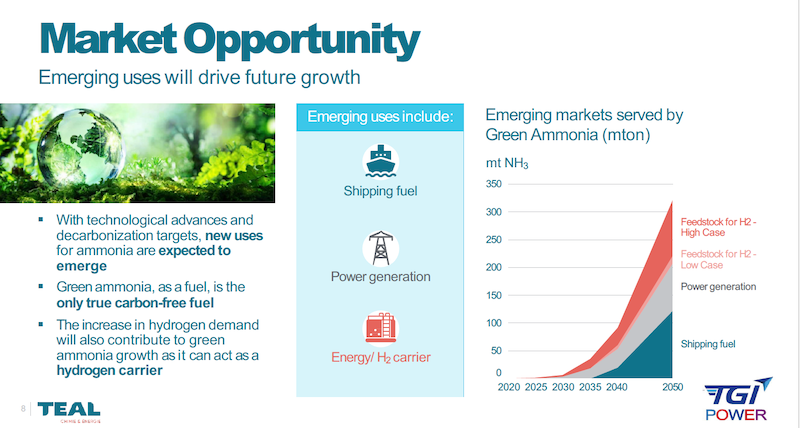
There’s a slide on that opportunity in the investment deck, it looks like the hockey-stick growth chart we’d expect for a new product, service or a molecule never before used. The project owners here refer to new uses of as much as 350 million tons of green ammonia per year — that’s a tripling of the global market.
When we say “green ammonia” it really means green hydrogen —the nitrogen component is green, anyway, taken from the air. There are several starting points for green hydrogen, the one that is getting the push from utilities and professional environmentalists is splitting water using electrolyzers and excess renewable power. Environmentalists like wind and solar for the reasons we all know — in the case of utilities, there is possibly another motive, the profit one, the opportunity to push out of lighting, heat and power and into chemicals.
By Right of Conquest
The grip that oil & gas has on worldwide chemical production is only by right of conquest and no one ought to complain when green electricity gives fossil fuels the gate — after all, years ago coal was the starting point for chemicals, until oil & gas shoved their way in. These days, it’s a green shove, and a good thing.
Ammonia fits into many markets — most people known the industrial chemical applications, growers know it as a nitrogen fertilizer compound, fewer people know it is a pretty good liquid hydrogen carrier, liquid ammonia has 2,00 times as much hydrogen per gallon than hydrogen gas does. So, there are many reasons to pursue green ammonia, and the opportunities in hydrogen are one of them.
Let a Hundred Flowers Blossom, a Hundred Projects Contend
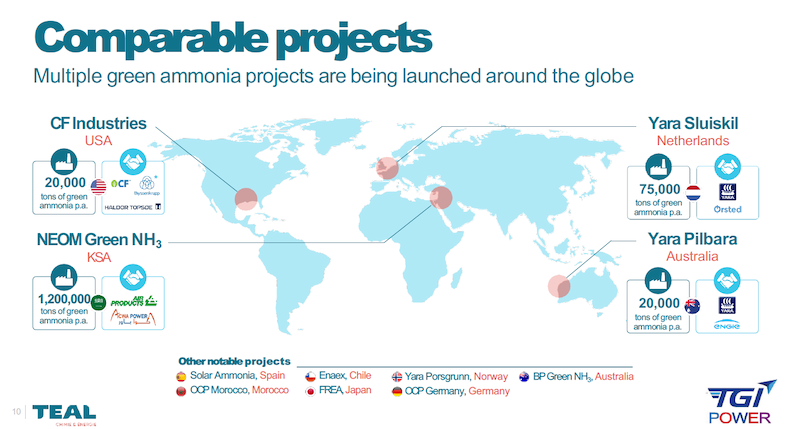
As this slide illustrates, there are many green ammonia projects in development around the world right now. In most cases, they are on the small side, the NEOM project in Saudi Arabia being one on the giant side. Teal and TGI Power are attempting to take scale to the next level.
Is blue ammonia a good idea? That is, dragging fossil natural gas out of the ground because it is cheap and sequestering the CO2 released by steam methane reformation so that it is a carbon-neutral source? Depends on how skeptical a view one takes of carbon sequestration. Here in Digestville, we see a lot less of the scrutiny given to proposed carbon caves than was given to the proposed nuclear storage facility at Yucca Mountain.
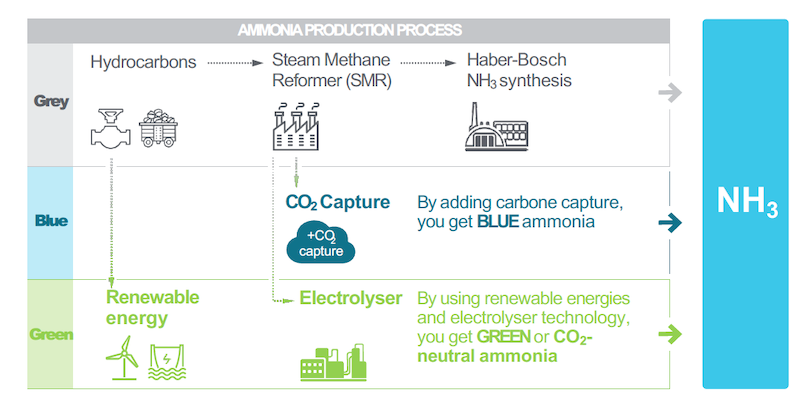
Then, the default position was if permanence could not be proved, then don’t build, because the risks are too great to do something and fail. Today, the default position appears to be if permanence cannot be proved, then build with fingers crossed, because the risks are too great to do nothing and fail. For now, let us mark it as “under debate, or ought to be” and otherwise cheer on the idea that, if the sequester is safe, why indeed not use an emissions-free source of hydrogen?
Is ammonia production actually an infrastructure project? I suppose that if investors wish to think of it that way, we’re all for it. Infrastructure doesn’t usually feature take-or-pay contracts, though they might have dedicated users (such as pipeline or cargo customers), and it’s probably better to concentrate on splitting hydrogen than on splitting hairs. Infrastructure investment, at least, is understood as a long-term play, not a get-rich-quick scheme, and there is a lot of capital on the sidelines looking for good and affordable ESG deal flow, as opposed to the risky or pricey kind, of which there are so many. So many moonshots, so many earth-shots, when what is needed is a good shot.
The Bottom Line
So, let’s raise a cheer for green ammonia, or blue, or teal. Above all, for the financiers, the unseen force that is taking a long-standing dream of utilities – the entry into chemicals – and making it possible. We could use a way to affordably store hydrogen as a liquid at ambient temperature and pressure — the sun’s method of using gravity being cheap but unavailable to us — and that alone is a good reason to watch these projects as they hover around the line between powerpoint-in-the-hand and steel-in-the-ground.
Category: Hydrogen, Top Stories















